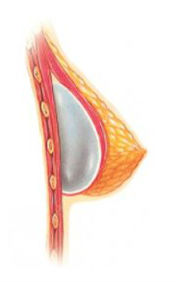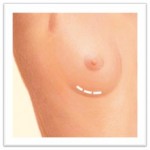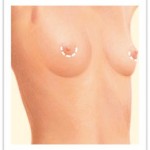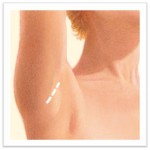Breast Implant Placement Techniques
- Submuscular Breast Implant Placement
- Dual Plane Breast Augmentation
- Inframammary-Periareolar-Transaxillary Approaches
Breast augmentation is the surgical placement of a saline or silicone implant under the skin, breast tissue, and muscle of the chest. The technique used to place your implants will depend upon multiple factors that will be discussed during your consultation. Dr. Neil J. Zemmel will ultimately recommend the technique that is safest and most appropriate for your needs. In most cases, he will utilize a Keller Funnel to place the implants, which is a tool used to insert implants into the breast pocket without ever being touched. This helps minimize trauma to the tissue, reduce the risk of infection and biofilm formation, and lower the rate of capsular contracture.
Submuscular Breast Implant Placement
 Dr. Zemmel believes placement of the implant beneath the pectoralis major muscle is critical for obtaining an excellent result. There are two reasons for this. First, placing the implant under the muscle provides an additional tissue layer over the implant, thereby limiting visibility of the implant. This thicker tissue “pad” hides the implant and gives a more normal contoured look and a gentle slope at the upper pole of the breast. The risk of traction rippling is lowered. Dr. Zemmel’s goal is to give you the most natural look possible.
Dr. Zemmel believes placement of the implant beneath the pectoralis major muscle is critical for obtaining an excellent result. There are two reasons for this. First, placing the implant under the muscle provides an additional tissue layer over the implant, thereby limiting visibility of the implant. This thicker tissue “pad” hides the implant and gives a more normal contoured look and a gentle slope at the upper pole of the breast. The risk of traction rippling is lowered. Dr. Zemmel’s goal is to give you the most natural look possible.
The second reason for submuscular placement is that it reduces the risk of capsular contracture. Both saline and silicone implants when placed beneath the muscle have a much lower rate of capsular contracture. Furthermore, submuscular placement of implants has the lowest risk of interfering with mammography.
Dual Plane Breast Augmentation
At Richmond Aesthetic Surgery, Dr. Neil Zemmel offers the dual plane breast augmentation technique for all candidates who qualify for breast augmentation surgery. This approach is one of the most advanced method of breast enlargement available, and involves placing the implants both under the chest muscle and directly beneath the breast tissue. This makes it possible for your breast augmentation surgery to result in an appearance that looks and feels both full and natural.
With the dual plane breast augmentation approach, the breast implants are placed under about one-third to one-half of the upper part of the chest muscle. The remainder of the implant is under the lower breast tissue.
The dual plane breast augmentation technique can be performed with silicone or saline breast implants. Dr. Zemmel feels this technique allows patients to experience a more natural-looking enlargement that is closer to the appearance and feel of full breasts that have had no cosmetic enhancement performed.
During your consultation, your surgeon will perform a full history and physical. He will measure many dimensions of your breasts and evaluate the quality and thickness of your breast tissue, chest muscle, and skin. You will also try on several different breast implant shapes and breast implant sizes, and together you will choose the best breast implant for your goals. Please contact Richmond Aesthetic Surgery for more information on the dual plane breast augmentation technique.
Inframammary-Periareolar-Transaxillary Approaches
Dr. Zemmel usually accomplishes sub-muscular placement or dual plane breast augmentation via a periareolar, inframammary, or trans-axillary (arm-pit) approach. While all three approaches can provide excellent enlargement of the breast with enhancement in contour, each technique has its unique benefits.
 The inframammary technique places the incision in the fold beneath the breast where the breast meets the chest wall. This was the first technique used to place breast implants, and it is the oldest and most traditional technique. A 2.5 cm ( one inch) incision is used for saline implants and 4 cm incision is used for silicone. The approach provides good access for the placement of the implant in the submuscular pocket, and it allows easy access to the pectoralis muscle for release. This approach also has an extremely low complication rate. The scars for this approach typically heal very well and at 6 to 12 months after surgery becomes a fine line well hidden in the breast fold from the frontal view. The scars are usually hidden with a normal bikini, but in very small bikini tops or topless may be visible.
The inframammary technique places the incision in the fold beneath the breast where the breast meets the chest wall. This was the first technique used to place breast implants, and it is the oldest and most traditional technique. A 2.5 cm ( one inch) incision is used for saline implants and 4 cm incision is used for silicone. The approach provides good access for the placement of the implant in the submuscular pocket, and it allows easy access to the pectoralis muscle for release. This approach also has an extremely low complication rate. The scars for this approach typically heal very well and at 6 to 12 months after surgery becomes a fine line well hidden in the breast fold from the frontal view. The scars are usually hidden with a normal bikini, but in very small bikini tops or topless may be visible.
 The periareolar technique uses a small 2-4 cm incision located around the bottom of the areola (the dark skin around the nipple). The incision is hidden at the juncture between the areolar and chest wall skin. Dr. Zemmel believes that this approach also allows better shaping of the breast pocket. The dual plane approach can easily be performed through this approach. The scars from this incision heal very well and this is our surgeon’s preferred approach. The final scar using a periareolar approach typically heals extremely well and often is barely visible 6 to 12 months after surgery.
The periareolar technique uses a small 2-4 cm incision located around the bottom of the areola (the dark skin around the nipple). The incision is hidden at the juncture between the areolar and chest wall skin. Dr. Zemmel believes that this approach also allows better shaping of the breast pocket. The dual plane approach can easily be performed through this approach. The scars from this incision heal very well and this is our surgeon’s preferred approach. The final scar using a periareolar approach typically heals extremely well and often is barely visible 6 to 12 months after surgery.
 The trans-axillary approach uses a small 2-3 cm incision located in the deep fold of the armpit. The most important benefit of this technique is that the breast is left without any incisions. The armpit scar however may be visible when in a tank top or in a bikini as the arms are raised and sometimes maybe thick due to the constant motion of the arm. Research has shown a significantly higher complication rate with this procedure including implant malposition. Furthermore, the dual plane technique cannot be performed using the approach. Silicone implants also may not be placed through this approach. Our surgeon will consider performing this technique if requested by a patient.
The trans-axillary approach uses a small 2-3 cm incision located in the deep fold of the armpit. The most important benefit of this technique is that the breast is left without any incisions. The armpit scar however may be visible when in a tank top or in a bikini as the arms are raised and sometimes maybe thick due to the constant motion of the arm. Research has shown a significantly higher complication rate with this procedure including implant malposition. Furthermore, the dual plane technique cannot be performed using the approach. Silicone implants also may not be placed through this approach. Our surgeon will consider performing this technique if requested by a patient.





